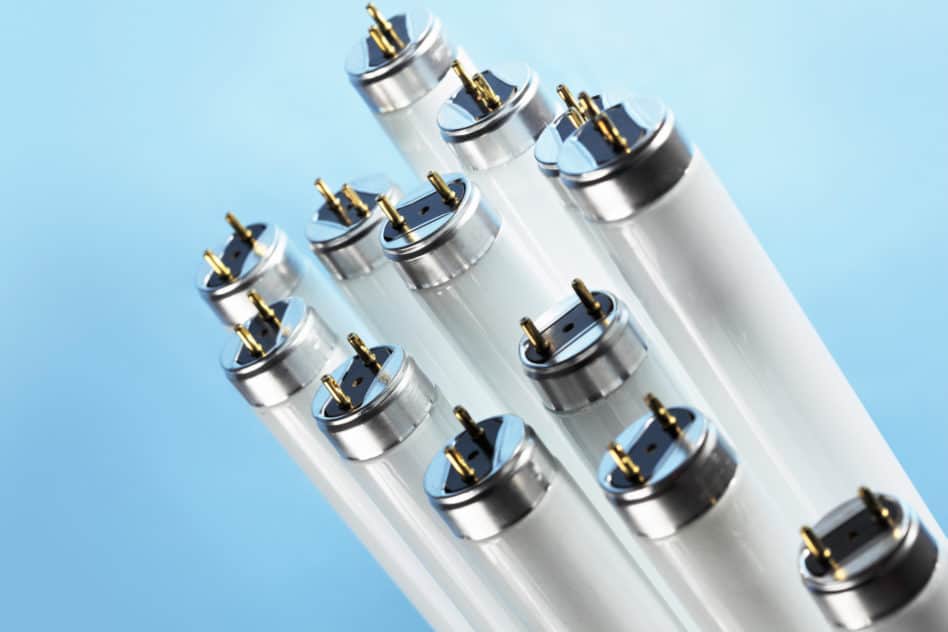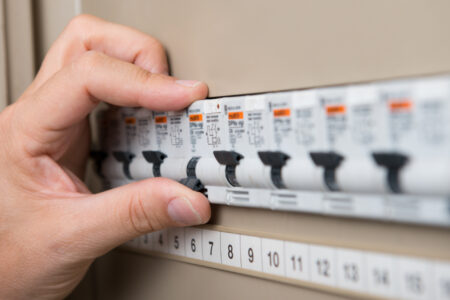Fluorescent tubes are used in different variants in many places both in the private and in the commercial sector. T5 and T8 fluorescent lamps are most frequently used in garages, workshops or as hall lighting. In this article you will find out how well the old fluorescent tubes perform compared to modern LED tubes.
Comparison of fluorescent tube vs LED tube
Fluorescent tubes are available in a wide variety of types and sizes. T5 and T8 fluorescent tubes are the most commonly used types today. These are used in private households, for example to illuminate basements or garages. In the commercial sector, fluorescent lamps are often used to illuminate offices, workshops or halls.
The larger fluorescent tubes are usually used where large-area and uniform lighting is required. Smaller sizes can be found in mirror cabinets or as ring lights in mirrors or magnifier lamps.
Common names for the tubes are:
- Fluorescent tube
- Fluorescent lamp
- Neon tube
The modern LED variants are called LED tubes. In the following sections you will find a comparison of the old and new technology as well as the advantages and disadvantages of both variants.
Comparison of functionality
Even if in many cases the fluorescent lamps can easily be exchanged for LED tubes, the internal function of both techniques is completely different.
How does a fluorescent tube work?
A fluorescent tube contains a noble gas which is ignited by a high voltage when switched on. This ignition voltage is generated by a choke or electronics in the ballast. During this process, the gas in the glass body is ionized and the fluorescent material on the inner wall of the glass begins to glow.
The first generation of fluorescent lamps was filled with neon gas, which is why the colloquial term neon tube is still frequently used today. Due to better properties, other noble gases such as argon or krypton are usually used in today’s fluorescent tubes.
How does an LED tube work?
A modern LED tube in principle is a normal LED illuminant. The special feature here is only the design. Due to the tube shape, the LED lamps fit into the sockets of existing lighting systems and can therefore be converted without much effort. The function of the LED lamp is otherwise identical to other LED illuminants:
The light-emitting diode is a semiconductor component. The LED chip emits photons, which we perceive as visible light. An LED tube contains a carrier board on which a large number of LEDs are soldered in a row. Furthermore, there is a power supply for generating the low voltage as well as an LED driver in the tubular housing.
LED vs fluorescent tube?
In terms of efficiency, the fluorescent tube is pretty good compared to incandescent and halogen lamps. But what does it look like compared to LED tubes? In the next sections you will find a detailed comparison of all important details.
Advantages of LED tubes
Very high efficiency
Depending on the type, LED tubes have a very high efficiency of 90 to 150 lumens per watt.
Good color rendering
Many LED tubes have a color rendering index of Ra > 80. There are also LED tubes with a Ra > 90 or even Ra > 95. The disadvantage is the decreasing efficiency at high CRI values.
Dimmable variants
LED tubes must be marked as dimmable so that they can be easily adjusted in brightness. The used dimmer must also be suitable for LED lamps.
Very long lifespan
LED tubes have a very long lifespan of 30,000 – 50,000 hours, depending on the type. Also the number of switching cycles is usually 100,000 and more.
No switch-on delay
LED tubes produce their full brightness immediately after switching on. There is no preheating phase or the typical flickering of fluorescent lamps.
Directional radiation
The beam angle of LED tubes is 160° for most tubes. Thus they radiate their full light completely into the room. There is no need to use or clean the reflectors.
No flickering
The LEDs in an LED tube are supplied with DC voltage by the LED driver. The output current is regulated with high frequency in kilohertz range. So no flickering is visible.
No mercury contained
There is no toxic mercury in LED tubes. Due to the electronic components, defective LED tubes must still be disposed of as electrical scrap.
Robust handling
LED tubes are often made of impact-resistant polycarbonate. This makes them insensitive to impacts and shocks.
Disadvantages of LED tubes
Higher purchase costs
The acquisition costs of LED tubes are currently several times higher than those of fluorescent tubes. Due to their long lifespan and high energy efficiency they pay for themselves after just a few years.
Advantages of fluorescent tubes
High efficiency
Depending on the type, fluorescent tubes have a quite high efficiency of 45 to 100 lumens per watt.
Color rendering
Many fluorescent tubes have a color rendering index of Ra 75 to Ra 85. There are now also fluorescent lamps with a Ra > 90. The disadvantage is the decreasing efficiency at high CRI values.
Dimmable with electronic ballast
Whether a fluorescent tube can be dimmed is depending on the used ballast. Conventional ballasts are not suitable for this, but there are special electronic ballasts which can adjust the brightness of the connected tubes.
Relative long lifespan
The lifespan of fluorescent tubes is between 5,000 and 20,000 hours, depending on the type and used ballast. On conventional ballasts, the lifespan of the tubes is more in the range of the lower value. The upper value can most be achieved on an electronic ballast with few switching cycles.
Economical costs
The fluorescent tubes themselves are very cheap. The ballasts, on the other hand, are more expensive, but they have a rather long lifespan.
Disadvantages of fluorescent tubes
Flickering on power-up
Fluorescent tubes with conventional ballasts are known to flicker when switched on. Electronic ballasts also enable fluorescent lamps to be switched on without flickering. However, a short switch-on delay of about one second due to the preheating phase still remains.
360° all-round radiation
Thanks to their design and functional principle, fluorescent tubes radiate their light uniformly in all directions. This is only advantageous in a few situations. In most cases, the light must be directed in the desired direction by a reflector. This also reduces energy efficiency.
120 Hz flickering
When operated with conventional ballasts, fluorescent tubes flicker at each zero crossing of the mains frequency of 60 Hz. The resulting 120 Hz flicker can lead to fatigue and headaches. The strobe effect is particularly dangerous in conjunction with rotating machines:
Despite the high speed, the impression can arise that the shaft of the machine only rotates slowly or even stands still. Electronic ballasts work in the kilohertz range and can reduce the flickering effect.
Contains toxic mercury
Fluorescent tubes contain toxic mercury. Make sure that the tubes do not break when they are replaced. They must also be disposed of as hazardous waste if defective.
Sensitive handling
The elongated tube is made of thin-walled glass and is sensitive to shocks and vibrations. The tubes must be handled with care, especially because of the toxic substances they contain.
Comparison table: fluorescent vs LED
In the following table you will find a compact overview of the most important details of the fluorescent tube compared to the LED tube.
| Property | LED Tube | Fluorescent Tube |
|---|---|---|
| Power-up Delay | immediately 100% light | flickering when switched on |
| Beam Direction | directional radiation | 360° radiation |
| Efficiency | 90 – 150 lm/W | 45 – 100 lm/W |
| Color Rendering | up tp Ra 95 | up to Ra 90 |
| Lighting Quality | flicker-free | 120 Hz flickering |
| Dimmability | dimmable type available | with dimmable ECG only |
| Harmful Substances | no mercury | contains toxic mercury |
| Lifespan | 30,000 – 50,000 hours | 5,000 – 20,000 hours |
| Robustness | resistent polycarbonate | fragile glass |
| Costs | higher acquisition costs | low-cost tubes, expensive ECGs |
Conclusion
LED tubes have almost only advantages compared to fluorescent tubes. After being switched on, these tubes light up immediately with their full light output without flickering. The environmental balance is also very positive due to the absence of mercury and the savings of 40 – 60% in energy consumption. The higher acquisition costs are quickly amortized due to the high efficiency and the long lifespan.






